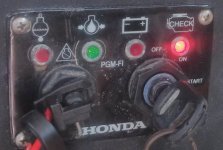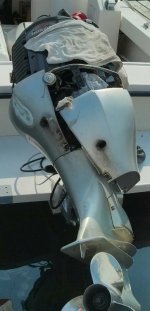Motor Baselines:
Error Condition:
After either idle or slow trolling, ~ 1k RPM the Green Light “ON” along with steady Check Engine “Mil” light is lit "ON", steady beeping. The frequency of failure time is variable, it occurs between 20 minutes and 2 hours. When the error occurs I’ll shut the motor off, the alarm stops, motor starts up OK with no alarm. Within in a ~10-20 minutes time-frame check engine light back on. DTC-1 code read prior to replacing the O2 sensor today, did not have time to recheck it, but I suspect same code.

From my Shop Manual it displayed a DTC code “1” which indicates:
NEXT: I just borrowed a portable 6 gallon gas tank, tomorrow I will run with fresh gas therefore by-passing the main fuel tank, maybe it's just stale fuel? Although on June 19th I did add 30 gallons of Med & Hi-Test Octane to the existing 50 gallons that was in the main tank. It did not seem to prevent the error, between that and what I read from other threads, that's why I went with the O2 sensor.
So far am I missing anything?
- May 2015 - Water Pump Replaced
- June 2015 - Engine mounted water separator drained and Fuel Filter replaced
- June 19, 2015 Fuel added fresh ~30 Gallons Med and Hi Test Octane, to the already ~50 Gal. stabilized from last season (The main tank has capacity of 120 gallons).
- June 2015, New Spark Plugs, IZFR6F11 (NGK) P/N 31916-ZY3-003,
- I do not believe that Bulletin #56 Exhaust Tube replacement was performed.
- VST (vapor separator tank) drained after every season, gas looked OK.
- Motor has 1544 Hours
- Cleared error using jumper and 5 times on/off sequence.
- June 29, 2015 Replaced 35655-ZY3-013 SENSOR, OXYGEN (Honda Code 7183742), did not fix
- Motor has 1549 Hours
Error Condition:
After either idle or slow trolling, ~ 1k RPM the Green Light “ON” along with steady Check Engine “Mil” light is lit "ON", steady beeping. The frequency of failure time is variable, it occurs between 20 minutes and 2 hours. When the error occurs I’ll shut the motor off, the alarm stops, motor starts up OK with no alarm. Within in a ~10-20 minutes time-frame check engine light back on. DTC-1 code read prior to replacing the O2 sensor today, did not have time to recheck it, but I suspect same code.

From my Shop Manual it displayed a DTC code “1” which indicates:
- Disconnected H2OS Connector
- Stale Fuel
- Short or open Circuit in H2OS wire
- Faulty H2OS (3655-ZY3-013, Honda Code 7183742) replaced 6/29/15 (FYI - Bulletin #56, Exhaust Pipes not sure if done?)
- Spark Plug misfire (#4, 5 or 6)
- Abnormally high fuel pressure (High Pressure Side)
NEXT: I just borrowed a portable 6 gallon gas tank, tomorrow I will run with fresh gas therefore by-passing the main fuel tank, maybe it's just stale fuel? Although on June 19th I did add 30 gallons of Med & Hi-Test Octane to the existing 50 gallons that was in the main tank. It did not seem to prevent the error, between that and what I read from other threads, that's why I went with the O2 sensor.
So far am I missing anything?
Last edited:


